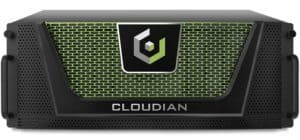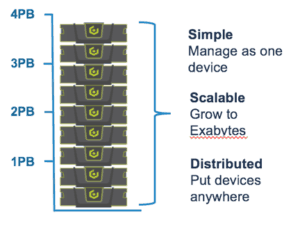Record Funding Round for Object Storage
Today Cloudian announced a $94M Series E funding round, bringing Cloudian’s total funding to $173M. This round is the largest ever for an object storage company, and exceeds all of Cloudian’s previous funding rounds combined. This majority came from investors new to Cloudian.

Object Storage Comes of Age
Clearly this funding signals growing investor interest in object storage. And because investors are by nature forward looking, it demonstrates their strong belief in the industry’s potential.
Here is why we believe object storage will not just grow, but further accelerate.
Capacity-Intensive Storage Challenges Go Mainstream
Capacity storage challenges are now mainstream. Once, the capacity problem was limited to a privileged few, such as supercomputer labs and government operations. Only big compute farms had the ability to generate and manipulate large amounts of data.
Today we all have the equivalent of yesterday’s supercomputers in our pockets, making capacity challenges ubiquitous. Anywhere you have cameras, sensors, or otherwise machine-generated data, you have a capacity challenge:
- A 4K movie requires 20X more storage capacity than a standard DVD movie
- Media production houses need assets to be instantly accessible for re-purposing in a dozen different formats, making high-capacity disk a must-have
- In security, video surveillance data retention requirements in some localities have increased from 90 days to 5 years, increasing storage demand by 20X. Intended to help fight terrorism, expanded retention requirement are being considered by 26 states
- Medical records that were once on film are now electronic, and must be retained
- A 3D chest volume scan produces 20GB of data, 100X that of a conventional cardiac MRI
- The emergence of AI/ML technologies will produce an entirely new class of data producers. A single autonomous driving test vehicle, for example, produces about 30TB of data per day
The Seeds of a Storage Revolution
Addressing this capacity challenge requires a fundamentally different kind of storage, with a quantum step forward from SAN and NAS. But to become a storage revolution, you need two ingredients:
- A growing problem: Flash storage is one example of a recent revolution. When virtual machines came along, there was a whole new premium on latency, making flash storage a great fit. Couple that with the falling cost of flash storage and you have the genesis of Pure Storage. Today, object storage solves the growing capacity problem.
- Must have an established standard: The idea of a “standard” sounds dull, but it can move mountains. Consider SAN storage, for example. It revolutionized the data center when Fibre Channel became the standard. Not long ago, object storage had no “standard”. Technically, it still does not, but it is clear now that the S3 API is the winner. Although confusingly named (Is it an API or a storage service?), it is fully accepted as the de facto standard. It is the NFS for the cloud era. (The NFS standard, by the way, created the file storage industry.) A standard unleashes the legions of developers to start writing to it and supporting it.

Think Big
With Cloudian, scale goes beyond just capacity. While object storage is of course known for scale (which is why Amazon, Google and Microsoft all built their cloud platforms on object), there are four dimensions where Cloudian adds important capabilities:
- Exabyte scale and modular growth: Just as critical as how big you grow, is simply how you grow. Cloudian scales in nodes (our appliances range from 48TB to 960TB each). They all work together. As the environment grows, the system actually gets faster and more efficient. This is different from traditional enterprise storage, where the overall systems tends to gets slower and more expensive as you grow (on a cost/capacity basis).
- Geo-distribution: High resolution data is generated everywhere, by cameras, sensors, machines, IT gear, and more. Much of that is most efficiently stored near its source. A medical clinic needs on-prem storage, as does a production studio. Cloudian can be everywhere in your organization, yet managed as a single, global fabric. Available as appliances, software, VMs, or even as a cloud-based application, Cloudian is easily deployed when and where you need.
- Cloud integration: Cloud is an important part of most IT settings, now. Cloudian is built to span your storage worlds, letting you manage on-prem and cloud storage as one. Effortlessly use the cloud for DR, capacity expansion, or content distribution. Cloudian’s native language is the S3 API, the de facto standard for the cloud. In hybrid cloud and multi-cloud configurations, Cloudian integrates easily and provides a single management view across environments.
- Embedded metadata and search: Finding data is sometimes the hardest part of storage. Cloudian lets you tag information with embedded rich metadata. So you can search data organization-wide, regardless of where it resides, using easily integrated Elastic Search tools.
Storage for Big Ideas
These attributes matter in use cases where storage is big and needs to be accessible. Examples are media and entertainment, healthcare, video surveillance, bio, IoT, and AI/ML. And of course, Cloudian is ideal for storage consolidation, such as data protection, and file synch and share. In each of these areas Cloudian solves real challenges today. In the future, as this funding round illustrates, we expect this list to grow as more and more data owners capitalize on the power and scale of object storage.


